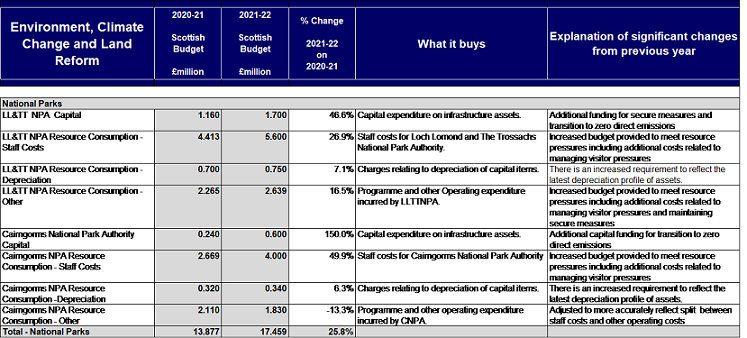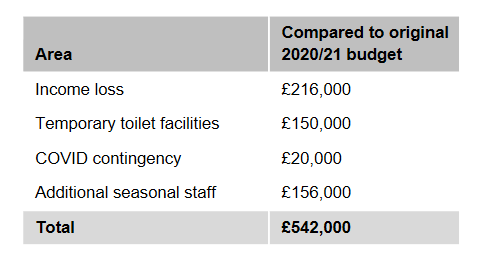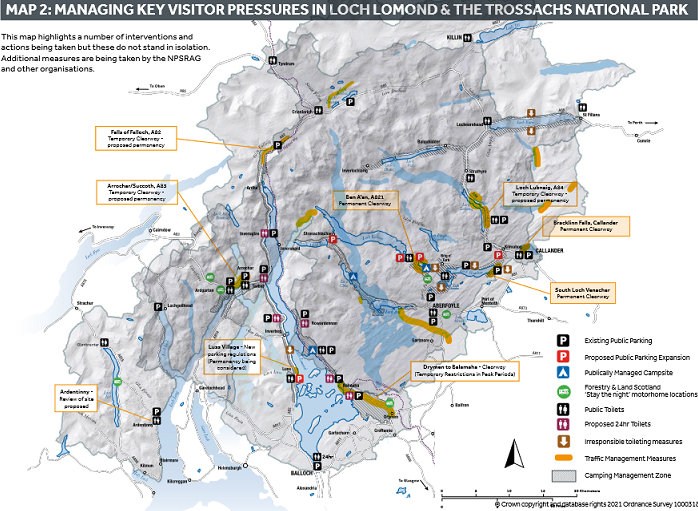 The Cairngorms and Loch Lomond and Trossachs National Park Authorities (NPAs) were both awarded significant increases in funding in the Scottish Government’s budget (see here), a significant turn-around in fortunes.
The Cairngorms and Loch Lomond and Trossachs National Park Authorities (NPAs) were both awarded significant increases in funding in the Scottish Government’s budget (see here), a significant turn-around in fortunes.
In September the Loch Lomond and Trossachs National Park Authority (LLTNPA) reported a significant hole in their finances, with a projected deficit – after yet more savigs/cuts – of £397k. This was then plugged by a £400k additional grant from the Scottish Government (see here). On 11th February, at the end of a debate in the Scottish Parliament (see here), the new junior Environment Minister, Ben Macpherson, rejected calls for a new National Park in Galloway largely on grounds of cost. What he didn’t say was that behind the scenes the Scottish Government was in talks with Scotland’s two existing National Parks about a large increase in funding. The budget approved by the Scottish Parliament provides a 26.9% increase in revenue for the LLTNPA and a 49.9% increase for the CNPA (Cairngorms National Park Authority).
While the increase in funding welcome, it raises serious questions about whether the Scottish Government has any coherent plan to manage the influx of visitors into the countryside when lockdown eases and also about whether the additional monies for National Parks will be well spent.
The Scottish Government’s funding of outdoor recreation and rural tourism
The Scottish Government’s explanation to the Scottish Parliament of the revenue funding increase, as set out above, is that it is primarily intended to mitigate anticipated visitor pressures this summer. There is, however, no mention of “visitor pressure” under the capital expenditure line. It appears therefore that while the Scottish Government has provided more money for visitor management (e.g Countryside Rangers), it has not recognised the need for investment in new infrastructure (e.g car parks, toilets) to support visitors. I say “appears” because the capital funding line for the LLTNPA refers to “secure measures”, the meaning of which is not clear.
The LLTNPA’s more detailed budget for 2021-22 (see below), suggests “secure measures” could cover items like vehicles, used to enforce the camping byelaws, and new automated number plate recognition systems to charge people for using car parks. If so, this capital investment will arguably make it harder, not easier, for people to enjoy the Loch Lomond and Trossachs National Park. It is notable that the CNPA, which has generally taken a much more supportive approach to visitors, has not been allocated any funding for “secure measures”.
In contrast to our NPAs, Scotland’s Local Authorities received a 2.5% increase in revenue funding. Once they have satisfied commitments already announced by the Scottish Government, like the public sector pay award, that leaves less than 1% to address a large array of problems from homelessness to potholes in our roads. Given those demands, it is to their credit that some Councils such as Perth and Kinross and Highland have allocated money to employ additional Countryside Rangers this summer and are undertaking other actions to prepare for the wave of staycations. Unfortunately it won’t be nearly enough.
The Local Authority funding shortfall won’t be filled by the Rural Tourism Infrastructure Fund, which was set up in 2018 and which has been increased from £3m to £6m. Indeed, two of the projects funded for next year, to improve visitor infrastructure around Loch Katrine and at Ben A’An and to renovate the toilets at Glen Shee, are both located in our National Parks.While both are very worthwhile projects, they illustrate that funding for visitor infrastructure and management is a postcode lottery in which generally our National Parks have been more successful than other areas.
The explanation for these disparities in funding lies with the Scottish Government spending portfolios and the power and interests of the relevant Cabinet Secretaries and their associates. Local Government has endured a decade of cuts and is slowly being strangled by the Scottish Government. Environment, Land Reform and Climate Change by contrast received a 9.7% funding increase. This made it possible for the Ministers responsible, Roseanna Cunningham and Ben MacPherson, to provide more funding to our existing NPAs to help meet the anticipated increase in visitors. What they didn’t do, however, was extend that funding to other parts of Scotland through creating new National Parks or increasing NatureScot’s budget (up 2.3%) so it could spend more on supporting Outdoor Recreation (outsides its own Nature Reserves)..
Rural Economy and Tourism received an even bigger increase, 39.5%, although much of this appears to have been a re-allocation of funds formerly provided by the EU to agriculture and tourism. The evidence, however, suggests that the tourism elements of the budget are being seriously misspent by the Cabinet Secretary responsible, Fergus Ewing. The money being wasted on the funicular railway (see here) – falsely claimed as needed to underpin tourism in Strathspey – palls into significance compared to the vast sums being thrown away by Visit Scotland. While their core funding only increased 0.8% to £41,412,000 this year, most of this is:
“To deliver high profile tourism marketing campaigns overseas and in the UK and a portfolio of national events that continue to grow sustainable tourism across Scotland.”
Why VisitScotland needs to spend a penny on marketing consultants and advertising this year, when rural Scotland will be thronged by domestic visitors and international travel and large events are likely to be highly constrained, is not clear. After wasting a similar amount of money last year, one might have hoped lessons would have been learned and Fergus Ewing would have channelled a large proportion of this budget into funding rural tourism infrastructure.
On Saturday (see here), the Ferret revealed that among the half a billion of public assets flogged off by Councils between 2015-19 were 29 public toilets. Unite was quoted as saying this has made work for those who drive for a living really difficult. They could have added it is even more difficult for tourists. It is cuts like this and the lack of any government strategy for investment in outdoor recreation that will be responsible for the challenges rural areas will face this summer.
Awarding extra money to our NPAs in isolation is not going to do anything to address these wider issues, though it is an opportunity for them to show the Scottish Government what a difference funding can make.
The LLTNPA’s plans for spending their extra fund £3 million
At their meeting on the 15th March the LLTNPA (see here for papers) decided to allocate £10,910,000 or 92% of their £11,877,000 anticipated income for next year, but to delay deciding how to spend the remaining £965,000. While Councils are struggling for every penny and faced with a tsunami of visitors, the LLTNPA is awash with power which could have been used to pay others to provide facilities. By June is will almost certainly be too late. The Annual Operational Plan approved at the Board Meeting shows why. Many of the actions are about developing plans – plans that should have been in place long ago – rather than actually doing anything:
- “Create a multi–year capital investment plan that considers what strategic investment would better support sustainable visitor management in the National Park”
- “Develop and deliver priority projects and targeted interventions, including those informed by engagement with the Litter Prevention Action Group”
- “Develop strategic thinking on how to deliver transport services and infrastructure that will promote modal shift from private car use to access congested places”
- “Work with partners to develop and deliver new transport”
Board Member Chris Spray, to his credit did try to ask about the timing of the various plans, both short-term and long-term, but was dismissed by Board Convener, James Stuart, who described this as “a comment to take away”. Responsibility for this sad state of affairs lies with Mr Stuart and senior staff. They have allowed work that was done in the past to develop plans for investment in new visitor infrastructure, such as the Five Lochs Visitor Management Plan, to be abandoned (see here) and let the Outdoor Recreation Plan became years out of date (see here). They were thus totally unprepared when the Scottish Government offered them money on a plate.
The allocations in the Board Budget Paper (see here) are so high level it is impossible to see how the LLTNPA proposes to spend all the additional funding. Spend on “visitor pressures” is summarised in one short paragraph:
“We have allocated significant spend to our COVID–19 response for the upcoming 2021 visitor season. This includes funding for temporary mitigation measures like temporary toilets, increased litter and waste picking, a bigger seasonal staff complement, and sustainable transport trials”
The only breakdown is for £500k specifically awarded by the Scottish Government to meet Covid pressures:

The largest allocation is to plug loss of income, including presumably the abandonment of The Shore (see here). How the proposed spend on Countryside Rangers and toilets relates to expenditure and what it means on the ground is not explained.
The paper titled “Joint Response Visitor Management Plan 2021 & Litter Update” Visitor Management Paper (see here) is equally vague:
“Toilets will be opened with increased capacities and opening times where possible, including 24hr access at some sites. Additional temporary toilet installation will be investigated and opened for times of peak demand at key locations” (My underlining throughout)
“Litter management will be undertaken by all partners on sites they are responsible for. Additional uplifts and bin capacity will be considered to meet demand”
“Temporary car parking capacity increases will (sic) investigated and if suitable enacted at key traffic hotspots for the peak season“.
An accompanying map illustrates just how little is actually planned:

- Credit for three out of the five new parking areas lies with the Sir Walter Scott Steamship Trust at Loch Katrine (funded by the Rural Tourism Infrastructure Fund eferred to above). Despite being by far the largest landowner in the National Park, the sum of Forest and Land Scotland’s contribution appears to be six “new” locations where they say campervans can stay overnight. FLS have miles of tracks and hard standing that could be used for parking with a little imagination, including off the new clearways where parking on the verge will be illegal.
- Despite the £150,000 budget, no locations are shown for temporary toilets. Instead of providing toilets at the places where the need for “irresponsible toileting measures” have been identified, marked with the brown arrows, the LLTNPA intends to hand out “poo bags” and lend trowels. All these sites are in the camping management zones, where the camping byelaws were supposed to stop such problems, and where new provision was once planned (e.g. North Loch Venachar and South Loch Earn).
- As for the toilets the LLTNPA proposes to open overnight, all public toilets should be open 24 hours anyway – but not having to lock them up each night should save money! I
- There are no plans for additional campsites or camping permit areas within the camping management zones, despite demand exceeding supply several times last summer. It should be clear now that the LLTNPA has completely reneged on its promises to increase camping places in future.
The Visitor Pressures map, on which this vague plans are supposedly based, is revealing because of its terminology:

Most problems are blamed on visitors not on lack of infrastructure:
- “irresponsible parking” rather than insufficient capacity;
- “antisocial behaviours associated with camping” rather than lack of camping provision;
- “irresponsible toileting” rather than insufficient toilets”;
- “irresponsible fire lighting” not the failure to provide barbecues;
- “littering” not absence of litter bins or binfrastructure as the park now calls it.
The attitude of the LLTNPA is fundamentally anti-visitor. Not a single Board Member at the meeting questioned this or made the case for places that might benefit from additional parking, temporary toilets, additional bins or further camping provision.
The CNPA’s budget and plans for visitors
I did not watch the CNPA Board Meeting live and unfortunately they now appear to have stopped leaving the recording on the web for a week – a step back for transparency.
The budget paper presented to the CNPA Board (see here), however, is far superior to that presented to the LLTNPA Board. In explaining that direct grant in aid has increased from £4.96 million to £7.1 million, with a further £2.29 million made available for peatland restoration, it also states these amounts were negotiated with the Scottish Government to meet objectives in current plans where shortfalls in funds/potential to invest more had been identified. As a result:
- in contrast to the LLTNPA, the CNPA budget balances and all the new money is allocated
- almost all items of expenditure are related to existing plans which have been approved by the Board, enabling anyone to see the rationale for the allocations (unlike the LLTNPA whose plans are all “under development”.

Moreover, the CNPA generally provides more detail about how the money will be spent. For example, in relation to visitor management, the structure and size of the new permanent Ranger Service is transparently described:

Along with this there is a description of what these staff will do and how they will relate to the Rangers who are employed by other organisations/landowners in the National Park (and in some cases partially funded by the CNPA). Just how many Countryside Rangers are now employed by the LLTNPA – there have been cuts – it’s impossible to tell.
One area where the CNPA does not have a fully developed plan is in relation to investment in visitor infrastructure but, even there, Annex 3 to the Tourism Action Plan (see here) sets out all the projects that have been agreed so far for this year. Its probably not enough but it does demonstrate a coherent approach and unlike the LLTNPA there are a number of practical measures to increase parking capacity at popular places for visitor across the National Park. The intention behind the CNPA’s proposals seems to be about assisting visitors to do the right thing, not blaming them or making it harder for them to visit.
What needs to happen
With the Cabinet Secretary responsible for National Parks, Outdoor Recreation and Access, Roseanna Cunningham, stepping down, there is an ideal opportunity after the Scottish Parliament elections for the new Scottish Government to look at how much investment is really needed to support rural tourism and how this should be allocated. In doing so, they could usefully learn from the successes in the Cairngorms and review how the Loch Lomond and Trossachs National Park Authority is being mis-managed.
While, given the silo mentality of government, the new minister is hardly likely to hand the LLTNPA’s unallocated £965k to local authorities, a sign of intent might be to hand to over to the CNPA given that their overall budget is still considerably less than that of the LLTNPA.

I find the dispair inducing state of the Falls of Falloch is illustrative of the failure you describe. Last time I stopped there I vowed it would be my last. The paths have been inadequate for the pressure. The result being that the natural environment of the falls area has been trampled, burnt and broken. No ranger presence, no waste management the sum total of visitor management is a temporary road sign saying don’t park on the verge. This is the result of negligence by park management.
A “hare” was set running by the BBC Countryfile program yesterday evening 28th March. Mention was made of a vigorous discussion now taking place. It concerned measures to refresh the manner in which national areas of outstanding natural beauty were to be defined and managed. The program implied that National parks were also to fall within the remit of a fresh ” visionary ” , but in fact “revisionary “, debate.
It struck me, as it may have done some others, that a fresh generation – for whom history is probably more about historic castles and the Romans; possibly even more about colonial repression and ethnicity – was now beginning to busy itself with reinvention of an historical Government department. It is not so very long since the great DofE ministry was shattered to component parts . Each division of responsibility for these Islands could then merit its own diversified committee structure and provide infinite roles for “managers” and lawyers ” to oversee some or other nonsense. Real leadership directing countryside policy from one Whitehall department close to the home office and treasury was broken up, the relics of it consigned to dusty archives , all this – such a short memory ago. For decades The “Department of the Environment” connected up thinking about planning and infrastructure, right across the UK landmass. This mega ministry confirmed a democratically appointed sense of direction in each electoral cycle with proper funding from the “top” .
So ,who today remembers that magical and idealistic period? .. anyone? Could it really appear to a new generation at last that National oversight of all of this was really not such a bad concept after all? Or is this new “hare” set running by the BBC yesterday simply a convoluted move to deny local democracy once again. Those concerned about management of Scotland’s upland areas should definitely feel free to discuss this >>>>while we have opportunity >>>>> while we may?
Never vote for any politician at any level who pledges that their administration will “spend more money on” anything without clearly defining what is to be bought, what the intended outcome is and how progress will be defined and monitored, or you just get this situation where huge sums of public money is placed blindly in the hands of the unelected and unaccountable to spend as they see fit.